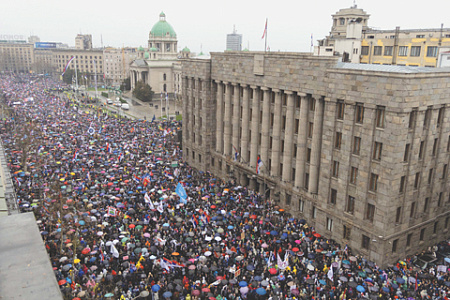
In Serbia, Parliament, which was closed three days earlier for security reasons, reopens on March 17. Large-scale protests took place in the country’s capital, Belgrade. According to the Interior Ministry, about 107,000 people attended the rally on Saturday, March 15. Perhaps there were several times more of them. Protests demanding the resignation of President Aleksandar Vucic may prevent the change of prime minister. The old one, Milos Vucevic, has resigned, which the deputies must approve this week.
Protests in Belgrade have been going on for four months after the collapse of the bridge in Novi Sad, which killed 15 people. The protesters, the core of which are students of the capital’s universities, insist on the dismissal of all those responsible for the bloody incident. They demand the departure of the president. Vucic himself tries not to outrage the students too much and admits that the authorities should “change.” So far, the result of these changes is Vucevic’s resignation, which the parliamentarians cannot approve in any way, including due to mass actions.
The actions near the local parliament and in the Pioneer Park looked threatening. The President said that the police did not use force against the protesters. The latter attacked tractors used by farmers who supported Vucic. Supporters of the current government, according to the students, provoked the clashes themselves. According to Vucic, 56 people were injured during the protests on Saturday.
Local media have noted the calm reaction of Western leaders to these events. No one condemns Vucic or demands his departure.
The protests coincide with other important events in the Balkans. The Prosecutor’s Office of Bosnia and Herzegovina (BiH) has issued an arrest warrant for the President of Republika Srpska, Milorad Dodik. In fact, this led to the threat of a new war on Bosnian territory. If the BiH authorities or EU peacekeepers try to arrest Dodik, it will instantly change the focus of attention of Serbian society. Protests have also swept through neighboring Hungary, where not everyone is happy with the policies of Hungarian Prime Minister Viktor Orban. He is, one might say, a key ally of Vucic in the European Union. The participants of the rally in Budapest, organized by the Hungarian opposition, expressed solidarity with the Belgrade protests.
The other day, Vucic gave an audience to the son of the President of the United States, Donald Trump Jr. It was the latter who suggested during their conversation that the protests could have been caused by someone’s foreign machinations. Vucic is much more cautious in this regard. He tries to avoid unnecessary accusations against the protesters. However, this was not always the case.
“Since 2012, many opponents of Vucic, and most importantly the Serbian Progressive Party, have accumulated complaints and fatigue from the current government. Vucic himself is only serving a second term as president, but the party has been in power longer. Many Serbs don’t like it. At the same time, Vucic is the president of the province, small towns and villages. He doesn’t have much of an electorate in the capital. And it is precisely those with whom he could not find a common language who are protesting – citizens, youth, students, intellectuals,” explains the editor–in-chief of the Balkanist portal.
The expert noted that the standard of living of Serbs has increased significantly in recent years. But many people no longer remember how they used to live, and they want further changes for the better. “But not so long ago Serbia was a very poor country. The improvement of the economic situation is largely due to Vucic,” says Bondarenko.
The president is unlikely to use force now. It is more likely that Vucic will try to wait it out, hoping that the protesters’ fuse will run out, or he will try to find a common language with them.
